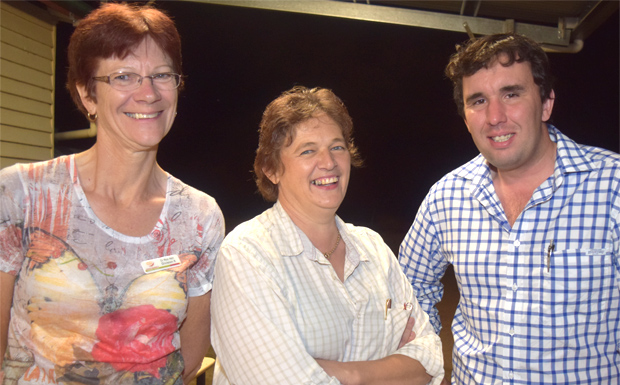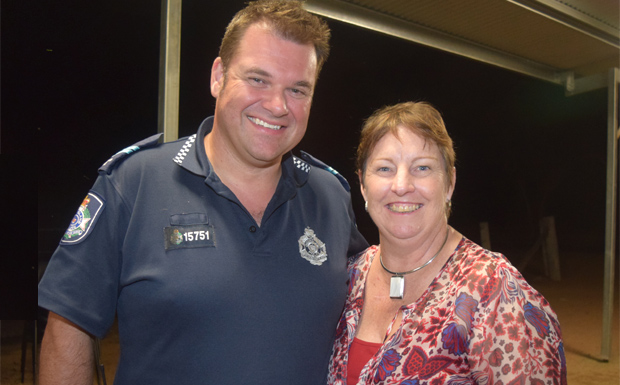
March 25, 2015
It costs $5 per square metre to reseal a road but 10 times as much to restore one that’s been broken apart due to poor maintenance, a meeting at Ironpot Hall heard on Tuesday night.
It costs between $3500 and $7000 to grade a kilometre of unsealed road, but about $46,000 a kilometre to do a full gravel and grade.
And it costs about $6000 a day to run one of Council’s road repair crews, which was why the South Burnett Regional Council tries to rotate its crews through the region rather than move them from one location to another on an ad hoc basis – it was more economically efficient to do things that way.
These surprising figures were shared with an audience of about 30 Ironpot and Burrandowan residents by the SBRC’s Roads and Drainage Manager Jeff Stephan.
The meeting, called by Burrandowan Race Club secretary Carolyn Stone to discuss local road maintenance matters, was also attended by Mayor Wayne Kratzmann, local divisional councillor Ros Heit, Roads Portfolio chair Cr Damien Tessmann and other residents from as far away as Durong and Kumbia.
After an informal barbecue dinner, Mayor Kratzmann opened the meeting with an overview of the Council’s current situation, explaining the Road Levy had to be introduced when the Council lost $1.4 million of Federal road grants in 2012.
This had reduced the region’s annual road maintenance budget to $2.8 million, which he said was “simply unsustainable”.
The Road Levy meant Council now operated three full-time road crews and spent about $6 million a year on maintenance, with 61 per cent of it going towards the upkeep of the region’s unsealed roads.
The Mayor then turned the meeting over to Mr Stephan, who explained the main issues Council faced with roadworks.
Mr Stephan said one of the hurdles the new Council had discovered was the quality of road grading in the past had often been imperfect.
One of the important things his section had been working on during the past few years was developing improved grading techniques that delivered a better result, ie. roads that lasted longer.
The SBRC was now one of the few councils in Australia – perhaps the only one – that had a specification for unsealed gravel roads, he said. And it was gradually bringing it to bear on all the region’s unsealed roads.
But it was a long process because of the thousands of kilometres that needed to be covered.
Mayor Kratzmann then took to the floor again to tell the audience that in his view, both the State and Federal Governments had “dropped the ball” on road funding.
“Thirty years ago when I was working for Wondai Shire Council, we used to receive about $465,000 a year for road maintenance. So if we say that Wondai is 25 per cent of the South Burnett, then the SBRC should be receiving four times that, which would be about $1.8 million. And with the passage of 30 years, that would be $7 to $8 million a year in today’s money,” he said.
“But we don’t receive anything remotely like that, nor does any other council.
“Our State and Federal Governments spend about 73 per cent of their budgets on welfare these days, and basic infrastructure like roads doesn’t get a look-in.”
The floor was then thrown open for questions, which came thick and fast.
Why didn’t the Council use local contractors to handle grading? Mr Stephan said this had been looked into, but studies found Council’s work crews were always cheaper than contractors.
Why did some roadworks in the area over the past few years seem haphazard? Mr Stephan explained they were flood recovery works and had been done that way because of the complex NDRRA rules imposed on Council by the Federal Government, which were “a bureaucratic nightmare”.
Why didn’t the council get gravel from local quarries? Mr Stephan said the old councils had used the best gravel from them many years ago. While some good local quarries still remained – and were used where possible – the new road-making techniques Council was using demanded gravel that could only be produced by bigger commercial quarries.
Questions were also asked about specific local roads.
Mr Stephan said Council relied on residents to report any problems with roads, and when a report was received an officer was despatched to take a look. If they agreed there was a problem, it was put into the road maintenance schedule.
“But just because you report a problem today and we look at it tomorrow, it doesn’t mean it will be fixed the day after,” Mr Stephan said.
“We have to wait until we have a road crew in the area because we can’t afford to pay for a half a day’s travel time to get them there for just one problem. But when they do come, they tend to fix up all the problems in that area, not just one.”
After question time guests held one-on-one chats with councillors and Mr Stephan over tea, coffee and cake.
Several told southburnett.com.au they were still frustrated about some local road issues, but felt they’d gained a much better understanding of Council’s position and thought the evening had been worthwhile.
Mayor Wayne Kratzmann said the key point he’d taken away from the meeting was that residents in the area wanted more communication from Council.
He said he would be very happy to hold future meetings to keep them updated on progress.
























